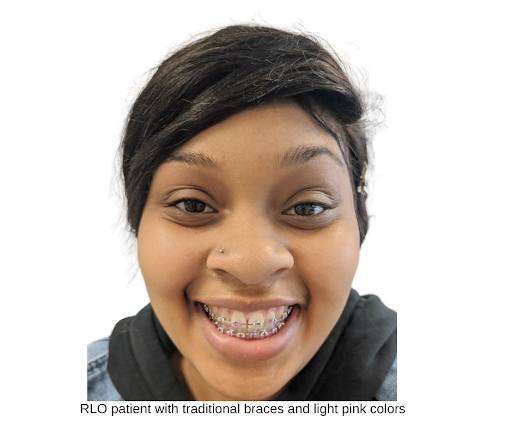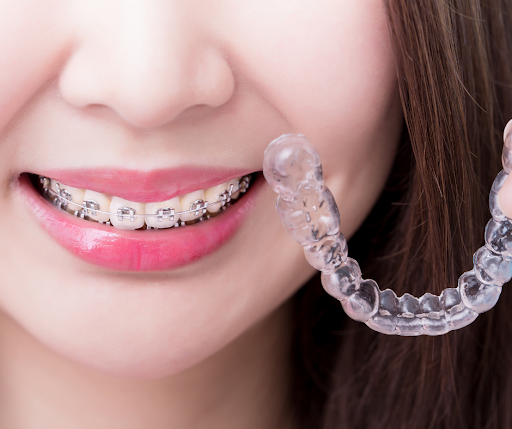Wondering about the differences between braces and clear aligners like Invisalign? Clear aligners are a subtle alternative to traditional braces for your orthodontist to use in achieving your confident smile. Here’s a comparison of these two great orthodontic options.
Method of Action
Traditional braces work by using brackets and wires to move the teeth incrementally. Either metal or clear ceramic brackets are carefully and strategically positioned on each tooth by your orthodontist. Then a specific wire is measured and engaged into the bracket and held on by small rubber bands called “colors.” Because the wire has memory, it returns to its original perfectly straight arch, bringing the teeth with it and guiding them into alignment.
Aligners feature variations of Essix material—a thin, transparent, and flexible plastic that can be formed into custom aligners using either a mold of the teeth or a 3D scan. These models are entered into a computer system that maps out progressive, incremental movements (about 0.25 mm of movement per tray) and applies them to a series of around 30 trays that are worn for 20-22 hours a day and changed out each week.
In 1997, two Stanford University students first had this idea of using a series of clear aligners that made incremental tooth movements over time. They named their method Invisalign, a name which dominates the orthodontic field to this day.
Comfort Level
Adjusting traditional braces involves replacing the stretched out and expended colored bands that engage the wires into the brackets, a process frequently referred to as “tightening” the braces. This reinforced engagement and other bracket and wire adjustments made by your orthodontist is the basic principle of orthodontic movement. You visit your ortho about once every six weeks to keep up with adjustments and keep improvements moving forward. Depending on the adjustments needed at your appointment, there are varying amounts and types of pressure applied to the teeth. The ligaments connecting the teeth to the jawbones (periodontal ligaments) get sore just as your hamstrings may after a run.
There can also be some irritation to the lips and gums with regular braces. New age brackets are much smoother than they used to be but there can be some areas of irritation from time to time. Lips develop tolerance over time, but dental wax can help. Traditional braces also pose the possibility of broken brackets and slipped wires, which can poke the lips until repaired.
Aligners are custom-made out of thin, flexible Essix material to fit seamlessly and comfortably. If aligners are causing irritation to the lips, this is usually easily resolved with the use of an emery board to smooth out any rough spots. If attachments are used with the aligner system, the mouth often needs to acclimate to these as it does to brackets.
Clear aligners are changed out and, therefore, “tightened” every week for incremental movements. Because of the more gradual nature of aligners the movements are usually somewhat less uncomfortable than traditional braces adjustment.

Length of Treatment
Generally speaking, an experienced orthodontist can accomplish a full smile makeover using aligners in about the same amount of time as traditional braces. Of course this varies depending on the complexities of the care plan. An average orthodontic case can be expected to take around 20-24 months. Missing adjustment appointments and wearing aligners inconsistently can extend treatment time substantially. Minor, limited cases are often taken care of with only a short series of aligners.
Capacity for Success
These days, with advancement in aligner technology, your orthodontist can achieve most goals equally with aligners as with brackets and wires. Whether braces or aligners are used for treatment is usually up to patient preference. However, depending on the exam, diagnosis, and care plan design, one method may be preferred over the other. In which case, your doctor should review the reasons and options. For example, braces are preferred in cases that involve extracted teeth or impacted canines, but aligners would be easier in response to an anterior overbite.
Convenience
Both braces and aligners come with their own sets of pros when it comes to convenience—
Metal braces
- Once bonded to your teeth, they are on for the length of treatment, so you can’t forget your braces at home or accidently throw them away at lunch.
- No self adjustments by changing them out each week.
- Dog can’t eat them (well, I suppose he can try but that will be unsuccessful if not awkward and disgusting)!
Aligners
- Trays can be removed at any time, which could be handy for special events or pictures.
- Fewer appointments as you’ll receive about 8-10 weeks of trays at a time.
- No emergency visits such as for broken brackets or wire pokes, which are associated with braces.
- Easier hygiene, as wires and brackets can be more difficult to clean around.
- No eating restrictions.

Aesthetics
Some people are going for the look of metal braces. The aesthetic of braces can be fun, especially with a variety of colors to choose from at each visit.
For those looking for a more subtle approach to traditional braces, there is a clear, ceramic bracket that can be used with no colors to blend into the tooth and matte hardwear to reduce the metal reflection. And of course, aligners are available as a virtually invisible option.
Therefore, regardless of the aesthetic you like, there are plenty of options.
Affordability
Depending on the orthodontic practice, aligners can cost quite a bit more than traditional braces due to the upfront cost of production.
At Red Leaf, we try to keep price out of the way as much as possible so the patient can make a decision based on preference without budget being the deciding factor. The down payment for aligners is a little more than braces, but overall, depending on exam findings and custom care plan, the costs of the two are typically comparable.
With a detailed understanding of the difference between Invisalign and regular braces, you can make an informed decision with your orthodontist about what’s best for you on your journey to a smile that makes you happy.




